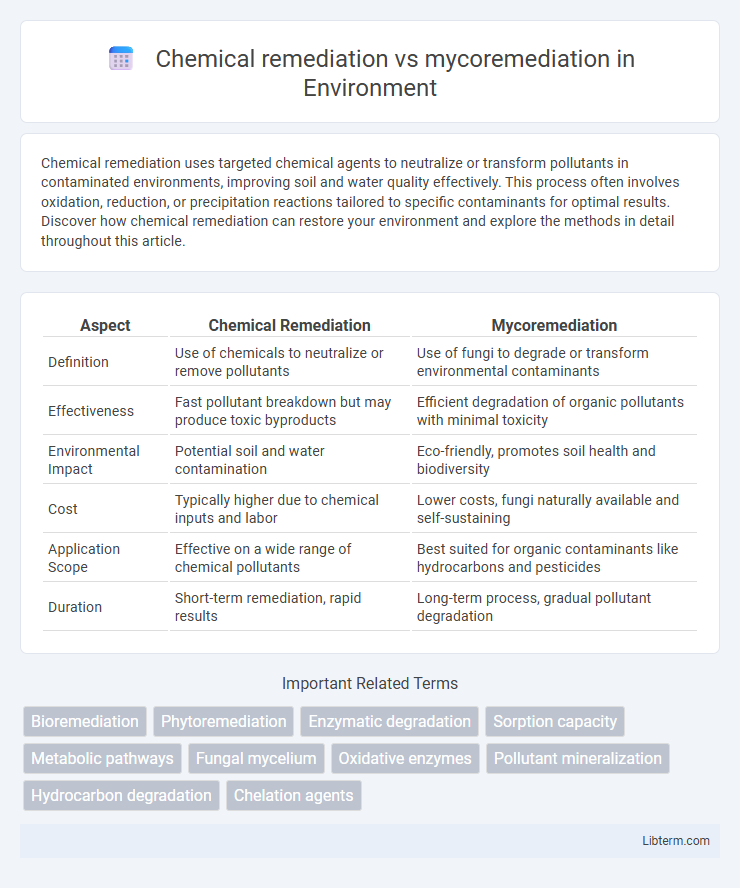Chemical remediation uses targeted chemical agents to neutralize or transform pollutants in contaminated environments, improving soil and water quality effectively. This process often involves oxidation, reduction, or precipitation reactions tailored to specific contaminants for optimal results. Discover how chemical remediation can restore your environment and explore the methods in detail throughout this article.
Table of Comparison
| Aspect | Chemical Remediation | Mycoremediation |
|---|---|---|
| Definition | Use of chemicals to neutralize or remove pollutants | Use of fungi to degrade or transform environmental contaminants |
| Effectiveness | Fast pollutant breakdown but may produce toxic byproducts | Efficient degradation of organic pollutants with minimal toxicity |
| Environmental Impact | Potential soil and water contamination | Eco-friendly, promotes soil health and biodiversity |
| Cost | Typically higher due to chemical inputs and labor | Lower costs, fungi naturally available and self-sustaining |
| Application Scope | Effective on a wide range of chemical pollutants | Best suited for organic contaminants like hydrocarbons and pesticides |
| Duration | Short-term remediation, rapid results | Long-term process, gradual pollutant degradation |
Introduction to Environmental Remediation
Environmental remediation involves the removal of pollutants from ecosystems to restore natural balance and protect human health. Chemical remediation uses synthetic reagents and processes such as oxidation, reduction, and stabilization to break down or immobilize contaminants in soil and water. Mycoremediation harnesses fungi's enzymatic capabilities to biodegrade organic pollutants, offering a sustainable and cost-effective alternative for treating complex environmental contaminants.
Understanding Chemical Remediation
Chemical remediation involves the use of chemical agents to neutralize, degrade, or immobilize contaminants in soil, water, or air, often employing oxidizing or reducing substances to transform hazardous pollutants into less harmful compounds. This method is typically faster than biological alternatives and can be precisely controlled to target specific contaminants such as heavy metals, hydrocarbons, and pesticides. Understanding chemical remediation requires knowledge of reaction mechanisms, site conditions, and pollutant chemistry to optimize treatment effectiveness and minimize secondary environmental impacts.
What is Mycoremediation?
Mycoremediation is an innovative environmental cleanup technique that uses fungi to decompose toxic pollutants and restore contaminated ecosystems. Unlike chemical remediation, which relies on synthetic compounds to neutralize contaminants, mycoremediation harnesses the natural enzymatic processes of fungal species like white rot fungi to break down complex organic pollutants such as petroleum hydrocarbons and pesticides. This biologically driven method offers a sustainable, cost-effective alternative for soil and water detoxification by transforming hazardous substances into harmless byproducts.
Mechanisms of Action: Chemical vs. Fungal Approaches
Chemical remediation relies on reactive agents like oxidizers, reducers, or solvents to degrade, transform, or immobilize pollutants through direct chemical reactions, often targeting specific contaminants with high efficiency. Mycoremediation utilizes fungal enzymatic activity, particularly ligninolytic enzymes such as laccases and peroxidases, to break down complex organic pollutants into less toxic forms via oxidative degradation and absorption processes. These fungal mechanisms enable the degradation of a broader spectrum of persistent pollutants, including polycyclic aromatic hydrocarbons (PAHs) and heavy metals, by transforming them into metabolizable or less harmful compounds.
Effectiveness in Pollutant Removal
Chemical remediation often provides rapid and controlled removal of pollutants through techniques like oxidation, reduction, and precipitation, making it effective for high concentrations of heavy metals and synthetic compounds. Mycoremediation leverages fungi's enzymatic abilities to degrade complex organic pollutants and transform heavy metals, showing superior results in breaking down persistent hydrocarbons and toxins in diverse environments. Both methods exhibit high effectiveness in pollutant removal, but mycoremediation offers a sustainable and less chemically invasive alternative with potential for biodegradation of contaminants resistant to traditional chemical treatments.
Environmental Impact and Sustainability
Chemical remediation often involves synthetic agents that can introduce secondary pollutants, potentially harming soil microbiota and aquatic ecosystems, whereas mycoremediation employs fungi to naturally degrade contaminants, minimizing environmental disruption. Mycoremediation enhances sustainability by promoting biodegradation through enzymatic processes that convert toxins into harmless byproducts, supporting ecosystem recovery and maintaining soil health. The fungal approach is generally more eco-friendly and cost-effective, aligning with sustainable environmental management practices aimed at long-term pollution mitigation.
Cost Comparison and Feasibility
Chemical remediation typically involves higher operational costs due to expensive reagents and energy-intensive processes, making it less feasible for large-scale or low-budget projects. Mycoremediation, utilizing fungi to degrade pollutants, offers a cost-effective alternative with lower energy requirements and biodegradable byproducts, enhancing feasibility in diverse environmental conditions. However, mycoremediation may require longer treatment times and site-specific optimization, influencing cost-effectiveness and practical application timelines.
Case Studies: Success Stories and Challenges
Case studies reveal chemical remediation's effectiveness in rapidly neutralizing pollutants like heavy metals and chlorinated solvents but often face challenges such as high costs and secondary pollution. Mycoremediation showcases success stories in degrading complex organic compounds, including petroleum hydrocarbons and pesticides, using fungi species like Pleurotus ostreatus, though challenges remain in scaling and environmental variability. Comparative analyses underscore the need for integrated approaches leveraging chemical and fungal methods to enhance remediation outcomes and sustainability.
Limitations and Potential Risks
Chemical remediation often involves harsh solvents and reagents that can introduce secondary pollutants, posing risks to soil and groundwater quality while potentially harming beneficial microorganisms. Mycoremediation, though eco-friendly, faces challenges such as slower degradation rates, limited effectiveness against certain pollutants, and dependency on specific fungal species sensitive to environmental conditions. Both methods require careful assessment of site-specific factors to avoid unintended ecological disruptions and ensure optimal contaminant removal.
Future Perspectives in Remediation Technologies
Chemical remediation technologies, such as oxidation and reduction processes, offer rapid contaminant degradation but often involve high costs and potential secondary pollution. Mycoremediation harnesses fungi's enzymatic capabilities to degrade diverse pollutants sustainably, with ongoing research enhancing fungal strain efficiency and environmental adaptability. Future perspectives emphasize integrating mycoremediation with advanced biotechnology and nanomaterials to improve degradation rates and expand applicability across complex contamination scenarios.
Chemical remediation Infographic

 libterm.com
libterm.com